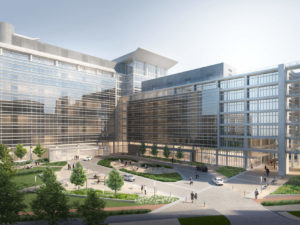This week we do a year-end overview of the state of the MoCo macro – 2021 jobs and resident employment data, along with the recently released 2020 personal income and GDP stats for the County. The numbers tell story that will sound familiar – unemployment is up, employment is down, and at-place employment losses were a lot steeper in MoCo than in the rest of the region. The partial recovery in at-place employment in early 2021 still leaves us well below pre-pandemic levels, and the rebound has not had any discernible effect on real-time indicators like office occupancy. Looking farther back, annual 2020 numbers for MoCo show a County that is more dependent than its regional peers on current personal transfer receipts and government employment, and one that really lacks private sector drivers of growth.
MoCo Jobs and Resident Employment
In thinking about the macro, a good place to start is at-place employment. How many more, or fewer, jobs are there in the County than there were a couple of years ago?
Over the time from 2018 through 2020, the annual employment numbers for MoCo fell steeply. Wage and salary employment fell by 31,481 (↓6.1%). I tend to focus most on wage and salary income because that is the income that is (a) steady, and (b) more clearly related to commercial property taxes. Proprietors’ employment also fell – by 14,514 (↓7.0%) – so total employment fell by 45,995 (↓6.4%) during that two-year period.
Now hold on, you say. There was a pandemic in there. And, indeed there was, is, and will be for what will feel like forever times seven. But MoCo’s job losses are quite a bit steeper than those in the region as a whole. DC Metro Area wage and salary employment and proprietors’ employment are both down 4.3% for the two years. This is a whole lot better than MoCo’s declines of 6.1% and 7.0%, respectively. Put a different way, MoCo’s job losses were 47% steeper than the rest of the region combined. Yeesh. So, if MoCo had performed as well (only as poorly?) as the rest of the region, there would be nearly 15,000 more jobs in MoCo than there are today.
In terms of resident employment, there are 35,000 fewer Montgomery County residents working than there were two years ago, and 12,000 more unemployed residents (23,000 have left the labor market since July of 2019 and even more if you look back to April of that year). So, there is a problem of MoCo’s jobs base shrinking, and there is also a problem of a lot of unemployed people who are still looking for work.
Some more recent data, such as the Quarterly Census of Employment and Wages and the Current Employment Survey indicate that the numbers may be heading in the right direction again, but that conclusion is not yet supported by leasing activity or absorption figures. I’m guessing that over time we’ll see the 2021 QCEW numbers as something akin to a “dead cat bounce.” If accurate, it is great that the County has gained 24,000 private sector jobs between the 2nd quarter of 2020 and 2nd quarter of 2021. But using these numbers that means that we still entered Q3 down 32,000 private sector jobs (lost 56,000 private sector jobs, gained back 24,000).
In any event, the recovery so far does not appear to be having much of an effect on the broader economy or drivers of County revenue. Illustrating the disconnect between the QCEW numbers and other economic signals, Montgomery County actually shed about 1.8 million square feet of office occupancy in 2021 (YTD). That ain’t nothing – in fact, it is roughly equivalent to the space required for 7,500 office workers (and again, that office market performance is much worse than what has occurred in Fairfax County during the same period). It wouldn’t be surprising to see some major revisions to preliminary economic data that would reconcile it to other signs of activity, like leasing activity, that give us more useful and accurate real time information.
MoCo Personal Income in 2020
We do now have annual personal income data for 2020. Overall, MoCo personal income increased by 3.9% from 2019 to 2020. It doesn’t take long to figure out why – 89.2% of that increase is a result of personal current transfer receipts (transfers to households for welfare and social assistance or emergency relief.
In terms of industries, most of the increases are where I expected them to be given the state of emergency – hospitals (↑10.0%), government and government enterprises (↑6.3%), insurance carriers (↑13.5%), and manufacturing (↑8.9%). With respect to manufacturing, 127% of the increase in personal income attributable to that industry was in the sub-industry of “chemical manufacturing” (bio and pharmaceutical manufacturing) so the strength was evident in a fairly narrow segment of the County’s economy. Personal income in chemical manufacturing increased by 21.6%. Clearly, the chemical manufacturing industry is a bright spot; however, it is one of those bright spots that happens to be causally related to a global pandemic that is wreaking havoc on the global and national economy…so, you know, the best-case scenario isn’t a ton of vaccine manufacturing in the County because that means that the global and national economic picture are pretty bleak.
Given that many of my clients are in the real estate industry, I’ll take a moment to acknowledge that the real estate industry as a whole was up 2.3%, but within that larger industry there were some dark clouds – e.g., real estate rental and leasing services was down sharply (↓6.9%). An adjacent area of concern is that management of companies and enterprises was down sharply (↓9.0%).
While I won’t “highlight” every industry that suffered in 2020, personal income in many of them was down sharply. For example, personal and laundry services (↓19.3%), accommodation (↓18.2%), and food services and drinking places (↓27.1%). Yikes. Obviously, these industries were able to rebound to varying degrees in 2021 – especially once employers were willing to meet the escalating price of labor (apparent in the summer 2021 wage data). Whether the bump in wages in those lower-wage, public-facing industries will be sustained in the second half of 2021 remains to be seen – that’s something to keep an eye on as the data is released and revised.
Before turning to GDP there are a few points worth making with respect to the differences between MoCo 2020 personal income and the 2020 personal income in the rest of the region.
- Personal income across all industries was up 5.5% in the region (including MoCo), compared to only 3.9% in MoCo alone.
- Personal income in state and local government in MoCo was up 6.2%, compared to 3.5% for the metro region including MoCo (MoCo actually represented 24.7% of the regional increase in personal income in state & local government and I gotta say, there aren’t many examples where MoCo represents a quarter of anything these days).
- The construction industry in MoCo experienced a 1.8% decline in personal income from 2019 to 2020, whereas for the entire region (including MoCo) it was up 3.2%.
- Real estate was a similar story – up 4.7% for the region (including MoCo), but up only 2.3% in MoCo.
- Similarly, personal current transfer receipts represented only 74.8% of the region’s year over year increase in personal income, whereas it was 89.2% of MoCo’s increase. Again, we badly need some private sector drivers of growth here…
For those who want to play with the numbers themselves, check out the BEA website. I used the CAINC5N data set.
MoCo GDP in 2020
In terms of 2020 GDP, I think the headline is that the County’s overall economy got smaller (↓1.7%), but the nuance is way more interesting. Government and government enterprises, unsurprisingly, grew by a whopping 6.7%, while private industries declined by 3.8%. Private sector services actually shrank by 4.5%, which is really bad in a county that touts its highly educated (and therefore service-inclined) workforce as a key asset.
Another interesting thing that is evident upon review of the GDP data is that there are some industries where wages went up and where the overall value-added output of the industry went in the other direction – the most interesting example of this (because of its size and relevance) is an old friend; the professional, scientific, and technical services in MoCo shrank by 3.5% year over year, while personal income in the industry increased by 3.5% during the same period. That’s good for workers in the short term, though things have a way of evening out over time because reduced margins can’t go on forever.
In terms of specific industries to highlight, another old friend makes an appearance – the nondurable goods manufacturing industry grew by 11.2% as measured by GDP (greater than the increase in personal income – keep in mind, it is a capital-intensive industry). And while the detail isn’t available at the County level, we can make an educated guess that this is mostly – if not entirely – driven by chemical manufacturing. And on the flip side, construction GDP in the County decreased by 6.9% while real estate and rental and leasing decreased by 3.6%. I think these will end up as examples of industries that were willing to reduce margins significantly in 2020. It will be interesting to keep an eye on those to see whether the “leveling out” ends up swinging wildly in the other direction. Increasing wages & salaries and decreasing profits can only go on so long…
And GDP also shows some of the same splits between MoCo and the rest of the region that we saw above with personal income.
- GDP across all industries was down 1.0% in the region (including MoCo), compared to a decline of 1.7% in MoCo alone.
- GDP across all private industry in the region (including MoCo) is down 2.4%, compared to 3.8% for MoCo alone.
- Similarly, GDP in private sector services fell by a more modest 2.7% for the region as a whole compared to 4.5% for MoCo alone.
- GDP in government and government enterprises in MoCo was up 6.7%, compared to 3.9% for the metro region including MoCo.
If you want to explore this on your own, check out the BEA’s CAGDP2 files.
Wrapping up
Very little in 2020 or 2021 economic data changes the narrative about the MoCo economy other than to reinforce the rapid divergence between the economy of MoCo and the rest of the region. And while many key 2021 data releases await in the months ahead, there isn’t much in the real time data that indicates that we’ll see a turnaround in the County’s relative performance. However, as every baseball fan knows, there’s always next year. That’s probably it for me in 2021. I’ll be back in early 2022 with a look ahead…and with “a look at looks ahead.” In the meantime, be safe, be well, and shop MoCo!


